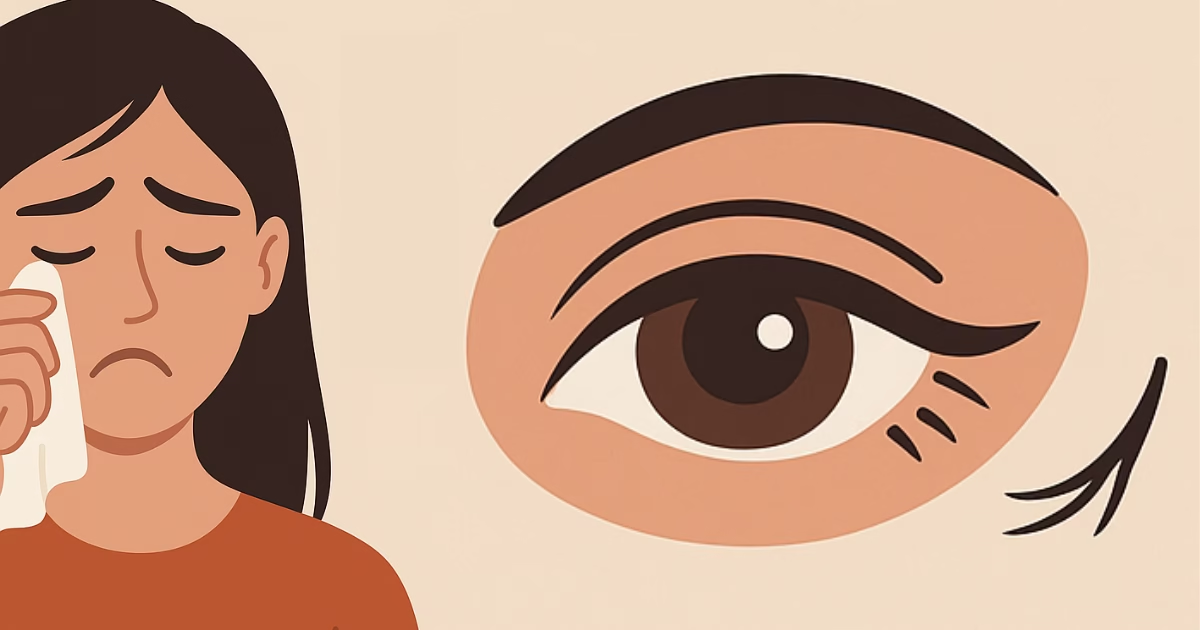We’ve all had moments where emotions take over and the tears start flowing. Whether it’s from sadness, stress, or even happiness, crying is a natural response. But if you’re someone who values long, full lashes, you may have asked yourself: does crying make your eyelashes fall out? It’s a common concern, especially after noticing a lash or two on your tissue after an emotional moment. The good news is, the relationship between crying and eyelash loss isn’t as straightforward as it might seem. In this article, we’ll explore the facts behind lash loss, separate myths from reality, and provide tips on how to keep your eyelashes healthy—even on the most emotional days. So if you’ve ever worried about the effects of tears on your lashes, you’re in the right place.
Does Crying Make Your Eyelashes Fall Out?
This is the big question—and the short answer is no, crying on its own does not directly cause your eyelashes to fall out. Your tears are mostly made of water, salt, and proteins, and they don’t contain anything that would naturally weaken or break down your lashes. So, shedding a few tears won’t damage the hair follicle or dissolve your lashes.
However, what happens around crying can lead to some lash loss. Many people rub their eyes when they cry, often using tissues, sleeves, or rough fabrics. This rubbing motion can tug at the eyelashes and cause them to fall out prematurely. If you’re wearing mascara, especially waterproof formulas, the lashes become stiff and can stick together, making them more likely to break or pull out when wiped.
So while crying doesn’t directly lead to lash loss, it can contribute indirectly—and that’s what you need to watch out for.
Understanding the Eyelash Growth Cycle
Before assuming crying is the reason your eyelashes are falling out, it’s important to understand how lashes grow. Eyelashes, just like the hair on your head, follow a natural growth cycle. This cycle includes three main phases:
- Anagen (Growth Phase):
This is the active growing stage. Eyelashes stay in this phase for about 30 to 45 days. - Catagen (Transition Phase):
After growth, the lashes enter a short resting phase. During this time, the follicle shrinks and prepares for shedding. - Telogen (Shedding Phase):
This is the final phase. Old lashes fall out, and new ones begin to grow in their place.
It’s completely normal to lose a few lashes every day—usually one to five. If someone notices eyelash loss after crying, it may simply be that the lashes were already in the telogen phase and ready to fall out.
Knowing this cycle helps explain why seeing a lash fall during or after crying doesn’t necessarily mean crying caused it.
How Crying Can Indirectly Lead to Eyelash Loss
While crying itself isn’t harmful to your lashes, certain habits and reactions during emotional moments can increase lash loss. Here’s how:
1. Rubbing Your Eyes
This is the most common cause of lash loss while crying. People often rub their eyes hard when wiping away tears. This friction can tug at the delicate lashes, pulling them out before their natural time.
2. Using Rough Materials
Tissues, napkins, or even your sleeves may be too rough for the delicate skin around your eyes. The pulling motion from wiping tears can easily dislodge lashes.
3. Wearing Mascara While Crying
If you’re wearing mascara—especially waterproof types—crying can cause lashes to clump. When you wipe or rub your eyes, those stiff lashes can break or fall out more easily.
4. Eye Irritation
Tears carry some salt and protein. While not harmful, excessive crying can cause eye irritation. Irritated eyes may lead to rubbing, inflammation, or other reactions that affect the lashes.
5. Stress and Hormonal Effects
Emotional stress that causes frequent crying can also impact your hormones. In some cases, hormonal shifts can lead to temporary hair or eyelash thinning.
So, while crying doesn’t chemically damage lashes, these indirect behaviors can contribute to noticeable lash loss over time.
Common Myths About Eyelash Loss and Crying
There are a few popular myths about crying and lash loss. Let’s break down the most common ones:
Myth 1: Crying Washes Away Your Eyelashes
Tears are gentle and natural. They don’t contain any harsh chemicals that could dissolve or weaken hair. Lashes don’t just “wash off” from crying.
Myth 2: Crying Weakens Hair Follicles
There’s no scientific evidence that tears weaken the follicles at the base of your lashes. The follicles stay healthy unless damaged by rubbing or infection.
Myth 3: Emotional People Lose More Lashes
People who cry more often aren’t at higher risk for lash loss—unless they rub their eyes aggressively or have other health issues affecting their lashes.
Myth 4: Waterproof Mascara Protects Lashes When Crying
While waterproof mascara may not run, it makes lashes stiff. This stiffness actually makes them more likely to break if you touch or rub them while crying.
Also Read: How to Master Unfocused Eyes on Command Like a Pro
Other Causes of Eyelash Loss (Not Related to Crying)
If you’re losing more lashes than usual, and it’s not because of crying, here are some other possible reasons:
1. Harsh Makeup Habits
Frequent use of eyelash curlers, old mascara, or rough makeup removal can damage lashes.
2. Eyelash Extensions and Glue
Using extensions too often or removing them incorrectly can weaken natural lashes.
3. Blepharitis
This condition causes inflammation of the eyelids and can lead to lash loss.
4. Alopecia Areata
An autoimmune disorder that causes hair loss, including on the lashes.
5. Thyroid Problems
Both overactive and underactive thyroid conditions can affect hair and lash growth.
6. Poor Nutrition
Lack of protein, iron, and other nutrients can impact lash health.
If lash loss seems sudden or excessive, it may be worth consulting a doctor or dermatologist.
How to Protect Your Eyelashes When You Cry
If you’re someone who cries often or deals with eye sensitivity, here are ways to protect your lashes:
1. Be Gentle with Your Eyes
Use soft dabbing motions instead of rubbing when wiping tears.
2. Choose Soft Materials
Use tissues with lotion or cotton pads instead of rough paper.
3. Remove Makeup Gently
Use oil-free, lash-friendly removers and avoid scrubbing your eyelids.
4. Avoid Waterproof Mascara if You’re Sensitive
It’s harder to remove and increases the chance of pulling out lashes.
5. Hydrate the Eye Area
Use a light eye cream or lash serum to keep the skin and follicles nourished.
Eyelash Care Tips for Healthy Growth
If you want strong, full, and naturally beautiful lashes, taking care of them daily is key. Eyelashes may seem tiny, but they need just as much attention as the rest of your beauty routine. Whether you wear makeup every day or keep things simple, these habits can help support healthy lash growth and prevent unnecessary lash loss.
1. Use Lash Serums
Lash serums are specially formulated products designed to nourish the hair follicles at the base of your lashes. These serums often contain ingredients like peptides, biotin, or panthenol, which are known to support stronger and longer lash growth over time. When applied consistently—usually at night—they can help reduce breakage and support thicker, fuller lashes.
Look for a serum that is free from harsh chemicals or fragrances, especially if you have sensitive eyes. Always apply using a clean applicator, and be patient—results usually take a few weeks to appear.
2. Try Natural Oils
If you prefer a more natural approach, oils like castor oil, coconut oil, and vitamin E are great options. These oils are rich in nutrients and help condition the lashes, making them less likely to become dry or brittle.
To use them, dip a clean mascara wand or cotton swab into the oil and gently apply it along the lash line before bed. Be sure not to get the oil into your eyes, and always wash your hands before and after application. Over time, these oils can help keep your lashes soft, flexible, and more resistant to damage.
3. Give Your Lashes a Break
Wearing heavy mascara, false lashes, or extensions every day can weigh down your natural lashes and weaken them. The glue from falsies or the tugging during removal can cause lashes to break or fall out prematurely.
Try to go makeup-free at least a few days a week, especially if your lashes are already thinning. Letting them rest gives the follicles time to recover and encourages healthier growth. If you do wear makeup daily, opt for lightweight, nourishing formulas that are easy to remove.
4. Eat a Balanced Diet
What you eat has a direct effect on hair health—including your eyelashes. A balanced diet rich in protein, biotin, iron, zinc, and omega-3 fatty acids can help support stronger and longer lashes.
Foods like eggs, salmon, avocados, spinach, sweet potatoes, nuts, and seeds are all excellent for lash health. Staying hydrated and avoiding processed foods also makes a difference. If you’re not getting enough nutrients from food alone, consider talking to a healthcare provider about supplements, especially biotin or omega-3s.
5. Avoid Excessive Curling
A lash curler can give your eyes that wide-awake look, but using it too often—or incorrectly—can actually cause lash breakage. Curling lashes when they’re dry is safer, but never curl after applying mascara. Mascara hardens the lashes, making them more likely to snap when pressed.
Use gentle pressure, hold the curler for just a few seconds, and don’t tug. If you notice your curler pulling on lashes or if the pad is worn out, it might be time to replace it. A well-maintained curler is much safer for your lashes in the long run.
When to See a Doctor About Eyelash Loss
While minor lash shedding is normal, certain signs may require professional advice:
- Sudden or patchy lash loss
- Redness, swelling, or pain around the eyes
- Itchy or flaky eyelids
- Hair thinning on the scalp or brows
- Signs of infection
If lash loss continues even after adjusting your habits, it may point to a health issue that needs medical attention.
Final Thoughts: Crying and Your Eyelashes
So, does crying make your eyelashes fall out? Not directly. Crying itself is harmless to your lashes. But how you treat your eyes during emotional moments can make a difference. Rubbing, wiping roughly, and using harsh makeup products can lead to lash loss.
Understanding your eyelash growth cycle and caring for your lashes properly will help keep them strong—even when life gets emotional. With gentle habits and a little attention, you can cry your heart out without worrying about losing your lashes.
Frequently Asked Questions
Q: How many eyelashes is it normal to lose in a day?
A: It’s normal to lose 1 to 5 lashes per day as part of the natural growth cycle.
Q: Can crying every day damage eyelashes long-term?
A: Not if you’re gentle. Crying doesn’t damage lashes, but rough wiping can.
Q: Is it better to avoid mascara if you cry often?
A: Yes, especially waterproof mascara, which can cause breakage when rubbed.
Q: Do tears contain anything that can damage lashes?
A: No, tears are mostly water and salt and don’t harm hair directly.
Q: Can stress-related crying cause hormonal hair loss?
A: Chronic stress may impact hormones and affect hair health, including lashes.

Hi, I’m Shafy Ali – a curious mind and passionate writer at Celiac Magazine. I cover a little bit of everything, from everyday tips and how-tos to deeper dives into topics that spark conversation. I enjoy turning research into readable, relatable content that informs and inspires. Whatever the subject, I aim to keep it clear, engaging, and genuinely useful.

